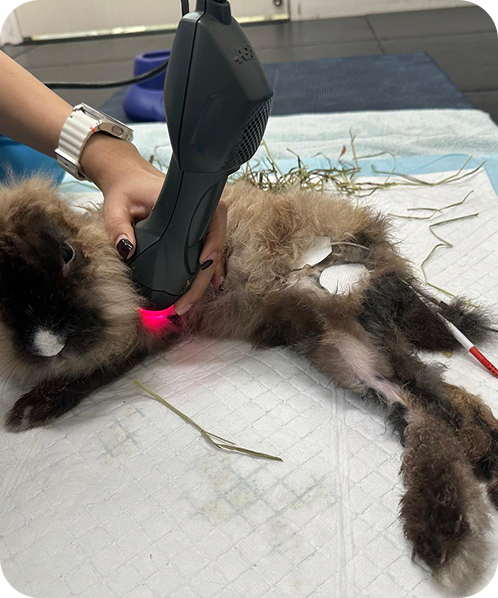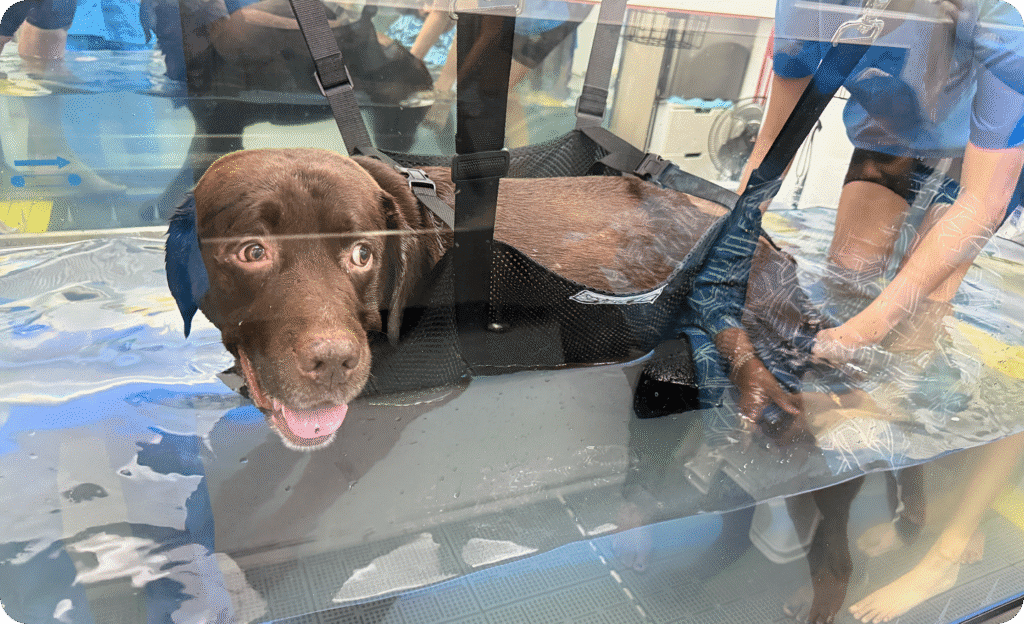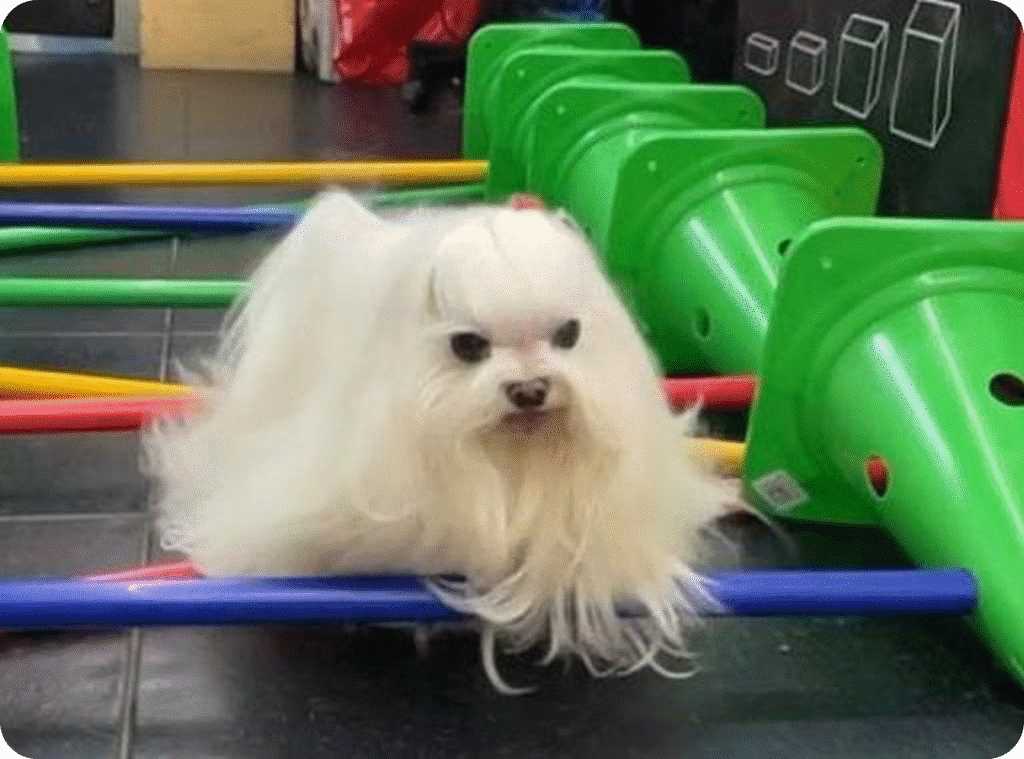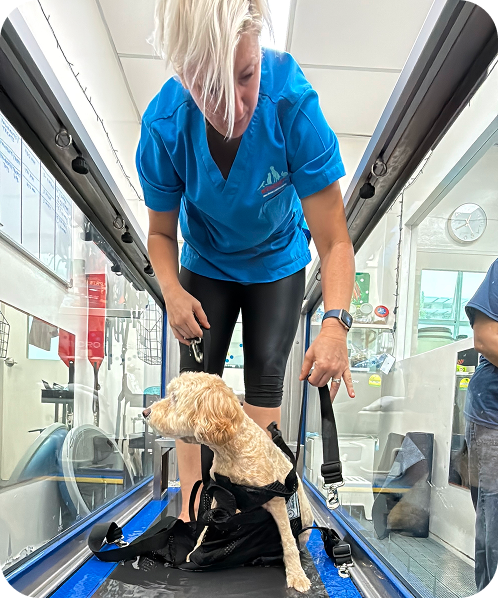

In my approach to physiotherapy rehabilitation, I treat every pet as an individual, recognizing that each one has unique needs, personalities, and challenges. My goal is to create tailored, customised treatment plans for each patient, with a focus on alleviating pain, accelerating recovery, and enhancing overall quality of life.
I believe that all pets, regardless of age or condition, can benefit from rehabilitation. This is particularly important after injuries, for maintenance in breeds predisposed to specific congenital or hereditary conditions (such as patella luxation or spinal diseases), or for improving the quality of life in pets suffering from conditions like cancer, arthritis, or obesity.


Hydrotherapy is a therapeutic approach that harnesses the physical properties of water such as buoyancy, viscosity, and hydrostatic pressure—to promote healing and enhance mobility in animals. It dates back to ancient Greek, Roman, Egyptian, and Chinese practices and is now widely used in both human and veterinary rehabilitation.
Typical sessions may include underwater treadmill work and guided aquatic exercises under a specialist’s supervision, optimizing recovery and wellness for both dogs and cats.

In practice, the buoyant environment of a warm water pool or underwater treadmill:
Our sling system is designed to elevate hydrotherapy safety, comfort, and efficiency for both the animal and therapist.

Secure and supported positioning lets pets focus on movement and exercise rather than balance control a vital adjunct to underwater treadmill or aquatic walk therapy.
Eliminates manual lifting during transfers, lowering the risk of caregiver injuries and enables therapists to more effectively treat pets with mobility challenges.


Ideal for post-operative or older pets it reduces joint stress and encourages movement sooner.

Every component from padding to secure straps—is designed to minimize anxiety and maximize steady, safe buoyancy.

Whether recovering from surgery, managing arthritis, or regaining strength after neuromuscular issues, pets benefit from consistent, gentle movement in water.
The Veterinary Rehabilitation and Hydrotherapy (VRH) team at Beecroft is committed to improving the quality of life for your beloved animal companions through enhanced mobility. We believe that movement and play are essential components of a fulfilling life.

Our rehabilitation services, including canine and feline rehabilitation, are tailored to a wide range of cases, from post-operative recovery and pain management to building strength and slowing the progression of degenerative conditions. We offer various therapies, including animal hydrotherapy, to help your pet achieve optimal mobility and well-being.
Veterinary rehabilitation plays a vital role in managing various conditions and improving your pet’s quality of life. Here is how our therapies can help:
Osteoarthritis
This degenerative joint disease often causes pain, stiffness, and reduced mobility. Canine and feline rehabilitation can help manage pain, improve joint flexibility, and slow the progression of osteoarthritis, allowing your pet to stay active and comfortable.
Mobility Issues
Whether the condition is caused by injury, surgery, or age-related decline, mobility issues can impact your pet's well-being. Our rehabilitation programmes can help restore strength, flexibility, and coordination, improving your pet's ability to move freely and enjoy their daily activities.
Muscle Weakness or Muscle Loss
Muscle weakness or decrease in muscle mass can result from various factors, including injury, surgery, or neurological conditions. Our targeted exercises and therapies can help rebuild muscle mass, improve strength, and enhance your pet's overall mobility.
Neurological and Orthopaedic Surgeries
Rehabilitation is crucial after neurological or orthopaedic surgeries to promote healing, reduce pain, and restore function. Our veterinarians will create a customised plan to aid your pet's recovery and help them regain their strength and mobility.
Conditions like IVDD (dog slipped disc) can cause pain, weakness, and mobility problems. Veterinary rehabilitation can help manage pain, strengthen supporting muscles, and improve your pet's overall function and quality of life.


Our video gallery showcases the journey of pets undergoing rehabilitation and specialist care at Beecroft. From hydrotherapy sessions to advanced recovery treatments, these clips highlight how our dedicated team combines science, compassion, and expertise to help pets regain strength, confidence, and mobility.
Watch our patients in action and see how veterinary specialist care makes a difference.
| Therapy | Description | Benefits |
| Acupuncture | Stimulates specific points with needles to promote healing, release natural painkillers, reduce inflammation, and enhance blood flow. | Manages pain, reduces inflammation, improves joint mobility, and supports overall healing. Particularly beneficial for arthritis and musculoskeletal conditions. |
| Neuromuscular Electrical Stimulation (NMES) | Uses electrical stimulation to strengthen muscles. Ideal for pets with weakness, atrophy, or recovering from surgery/injury. | Improves muscle strength and function, reduces pain, and aids in nerve regeneration. Beneficial for neurological and orthopaedic conditions. |
| Ultrasound Therapy | Employs high-frequency sound waves to increase blood flow, reduce pain and inflammation, and promote soft tissue healing. | Accelerates healing, reduces pain and swelling, and improves flexibility. Effective for musculoskeletal injuries, arthritis, and post-surgical recovery. |
Therapy Class IV Laser Therapy | A non-invasive treatment that uses high-intensity laser light to reduce pain, inflammation, and promote healing in various conditions. | Class IV Laser Therapy is a safe, non-invasive treatment that utilizes focused light energy to reduce pain, decrease inflammation, and accelerate healing in pets. It is commonly employed for conditions such as arthritis, various joint and muscle injuries, post-surgical recovery, and wound healing. This therapy works by improving circulation, stimulating cellular repair, and encouraging the release of the body’s natural pain-relieving chemicals. |
| Underwater Treadmill (UWTM) | Provides low-impact exercise in water, reducing stress on joints while building strength and improving cardiovascular health. | Improves strength, endurance, flexibility, and balance. Ideal for post-surgical recovery, arthritis, obesity, and neurological conditions. A key component of animal hydrotherapy. |
| Therapeutic Massage | Uses manual massage techniques to relax muscles, improve circulation, and reduce pain. | Relieves muscle tension, improves flexibility, reduces pain, and promotes relaxation. Beneficial for pets with injuries, post-surgical recovery, or age-related stiffness. |
UWTM is a low-impact therapeutic exercise that leverages the unique physical properties of water to promote muscle building and strengthening. Hydrotherapy improves overall stamina, flexibility, and proprioception, making it beneficial for animals in post-surgical recovery, or who may have musculoskeletal disorders, chronic orthopedic conditions, muscle atrophy, or limb weakness.
Equipped with state-of-the-art rehabilitation equipment, including underwater treadmills, laser therapy, and electrical stimulation units, this allows us to provide the most effective and comprehensive rehabilitation programmes for your pet.
Whether your pet needs post-operative care, pain management, or physical therapy, we have the expertise and resources to help them recover and thrive.
Signs your pet might benefit from veterinary rehabilitation include pain, stiffness, limping, weakness, difficulty walking, loss of balance, recent surgery or injury, and chronic conditions like arthritis.
We will start by conducting a thorough assessment of your pet’s condition, including a physical examination, medical history review, and diagnostic tests. This information will help us develop a personalised rehabilitation plan that is tailored to your pet’s specific needs and goals.
The rate of improvement will vary depending on the severity of your pet’s condition and the type of rehabilitation programme they are undergoing. However, you can typically expect to see some improvement within a few weeks.